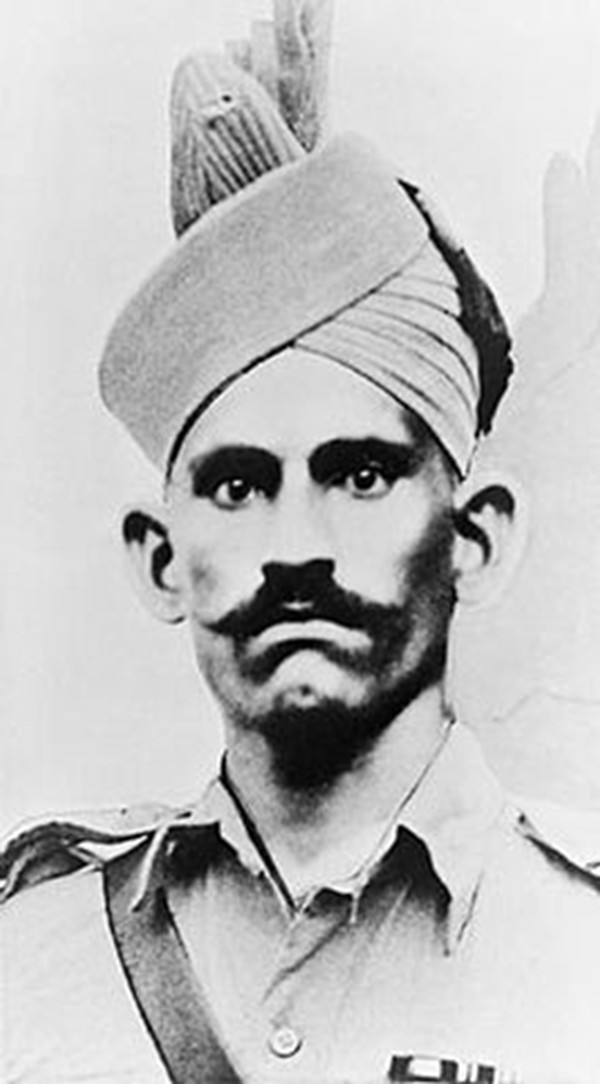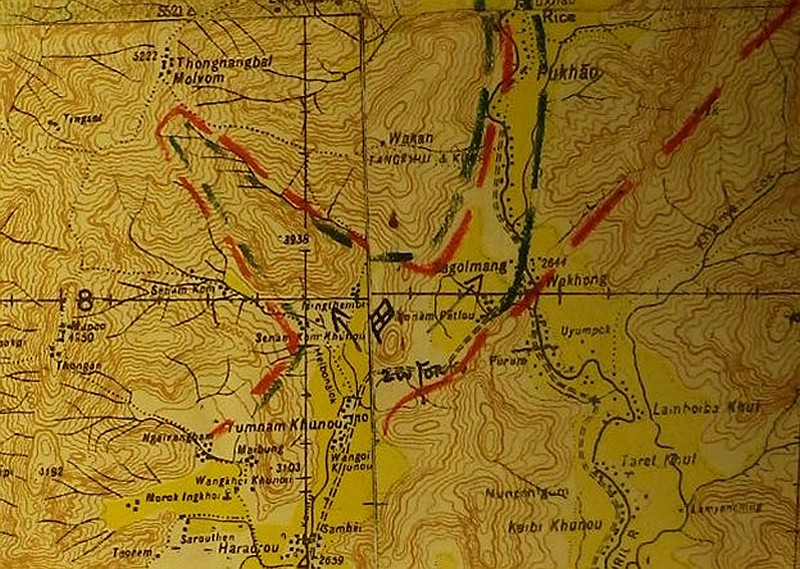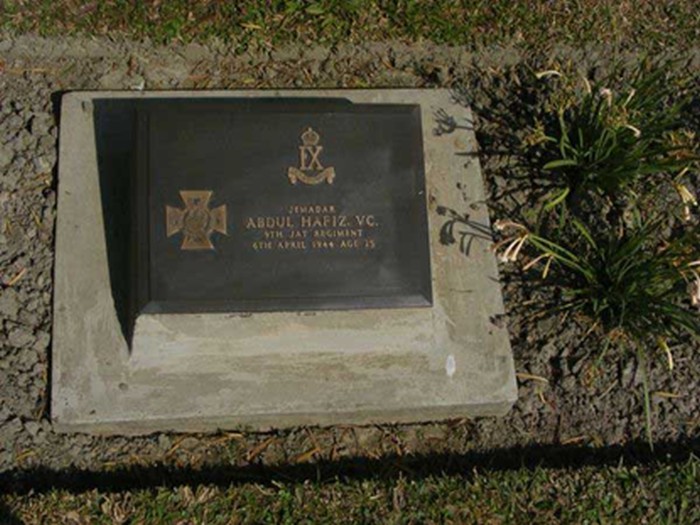Kalanaur (Gurudaspur District), PUNJAB / (buried in Imphal, MANIPAL) :

Abdul Hafiz was born in Kalanaur Village in Punjab, India. His father name was Nur Muhammad and mother was Hamidan. He was married to Jigri Begum.
Jemadar Abdul Hafiz of 3/9 Jat won the Victoria Cross- the first Muslim soldier to do so in the Second World War ( Imphal, 1962). He won the VC in a feature named “Runaway Hill” which is located at the corner of the road leading to Isingthembi on the Pangei- Sagolmang Road (see map).
“He served with the 9th Jat Regiment with service number 11460. Jats are an ethnic group who follow a variety of religions. The Jat battalions were structured around two companies of Hindu Jats, one company of Punjabi Muslims and one company of Musulman Rajputs, a mix requiring not only good purely military leadership to ensure the respect of all but sensitivity for different cultures and beliefs”. (CWGC)
The 3rd Battalion, 9th Jat Regiment, was part of the 5th Indian Division during the Imphal campaign and at the time of this action were operating in the Nungshigum area to the north east of Imphal as part of a force advancing up the Litan road which was of strategic importance to both sides as it offered one of the few approaches to the Imphal plain. The attacks in and around Nungshigum Hill, of which Abdul Hafiz’s was one, continued until 13th April 1944 when the hill was finally captured.

According to War Diary dated 6th April 1944, 3rd battalion, 9th Jat Regiment,
” D Coys standing patrol the high ground at RK 420790 was driven offduring the night by thr enemy. At approx. 0930 hrs. D Coy counter attacked the enemy from the high ground killing at least 45-50 Japs and capturing a great deal of equipment. Our losses were 4 killed and 12 wounded including Major RITCHIE M.C. wounded. 1 Pl. B Coy supported by 1 tp of “HONEYS” did a sweep at approx 0900 hrs to the village ISINGTHEMBI RK 410800 where enemy had been reported- N.E.S.. 1 Pl. B Coy and the GR Pl at 1630 hrs ordered to NUNSHIGUM RK 4375 to take up a defensive posn”.
“It was by Runaway Hill that the Division’s third Victoria Cross was won. Before dawn on April 6, during this original encircling movement, at a time when we could not be sure when they would appear next, the Japanese attacked one of Colonel Gerty’s standing patrols. By driving the Jats off, they secured a hillock that overlooked the main company position. Jemadar Abdul. Hafiz was ordered to recapture the hill with two sections of his platoon.
After an artillery bombardment by Bastin’s 4th Field Regiment, Abdul Hafiz led his Jats in to the attack. They charged up the hillside that was bare of cover, shouting their war-cry as they neared the top. Then the waiting Japanese opened fire with machine-guns. On the approaching Jats they threw down grenades. Jemadar Abdul Hafiz was wounded at the outset. A bullet struck him in the leg. Yet he dashed forward and seized the enemy machine-gun by the barrel, while another Jat killed the Japanese gunner.
The Jemadar then took up a Bren gun dropped by one of his men who had fallen wounded, and notwithstanding the heavy fire from the enemy positions on this hill and on a feature to the flank, he shot a number of the Japanese soldiers. And so fiercely did he lead his men that the enemy ran away: hence the name Runaway Hill. But Jemadar Abdul Hafiz was mortally wounded in the chest, still grasping his Bren gun. To his men he shouted in his own language, “Reorganize! I will give you covering fire.” But he died,. without having been able to pull the trigger. He was awarded the Victoria Cross, posthumously, and was the first Muslim soldier to win this decoration in the Second World War” ( Ball of Fire – Antony Brett-James 1951) .
Geoffrey Evans and Antony Brett-James in their book “Imphal” give the account of how the feature got its name of Runaway Hill . ” Undaunted, Abdul Hafiz rushed forward as best he could and with supreme bravery seized the barrel of the machine gun while a second Jat Killed the gunner. That done, he saw a bren automatic which had been dropped by one of his wounded men, and picking it up without hesitation, he opened fire on the enemy to such effect that those whom he did not kill ran away as fast as they could. For this reason the hill became known as ‘Runaway Hill’, a name which it retained throughout the battle”.

His citation reads as follow:
The KING has been graciously pleased to approve the posthumous award of the VICTORIA CROSS to:–Jemadar Abdul Hafiz (11460), 9th. Jat Regiment, Indian Army.
In Burma, in the early hours of the 6th April, 1944, in the hills 10 miles North of Imphal, the enemy had attacked a standing patrol of 4 men and occupied a prominent feature overlooking a Company position. At first light a patrol was sent out and contacted the enemy, reporting that they thought approximately 40 enemy were in position. It was not known if they had dug in during the hours of darkness.
The Company Commander ordered Jemadar Abdul Hafiz to attack the enemy, with two sections from his platoon, at 0930 hours. An artillery concentration was put down on the feature and Jemadar Abdul Hafiz Khan led the attack. The attack was up a completely bare slope with no cover, and was very steep near the crest. Prior to the attack, Jemadar Abdul Hafiz assembled his sections and told them that they were invincible, and all the enemy on the hill would be killed or put to flight. He so inspired his men that from the start the attack proceeded with great dash.
When a few yards below the crest the enemy opened fire with machine-guns and threw grenades. Jemadar Abdul Hafiz sustained several casualties, but immediatetly ordered an assault, which he personally led, at the same time shouting the Mohammedan battle-cry. The assault went in without hesitation and with great dash up the last few yards of the hill, which was very steep. On reaching the crest Jemadar Abdul Hafiz was wounded in the leg, but seeing a machine-gun firing from a flank, which had already caused several casualties, he immediately went towards it and seizing the barrel pushed it upwards, whilst another man killed the gunner.
Jemadar Abdul Hafiz then took a Bren gun from a wounded man and advanced against the enemy, firing as he advanced, and killing several of the enemy. So fierce was the attack, and all his men so inspired by the determination of Jemadar Abdul Hafiz to kill all enemy in sight at whatever cost, that the enemy, who were still in considerable numbers on the position, ran away down the opposite slope of the hill. Regardless of machine-gun fire which was now being fired at him from another feature a few hundred yards away, he pursued the enemy, firing at them as they retired.
Jemadar Abdul Hafiz was badly wounded in the chest from this machine-gun fire and collapsed holding the Bren gun and attempting to fire at the retreating enemy, and shouting at the same time “Re-organise on the position and I will give covering fire.” He died shortly afterwards.
The inspiring leadership and great bravery displayed by Jemadar Abdul Hafiz in spite of having been twice wounded, once mortally, so encouraged his men that the position was captured, casualties inflicted on the enemy to an extent several times the size of his own party, and enemy arms recovered on the position which included 3 Lewis Machine-guns, 2 grenade dischargers and 2 officers’ swords. The complete disregard for his own safety and his determination to capture and hold the position at all costs was an example to all ranks, which it would be difficult to equal.—( London Gazette. Issue 36627, 25th July 1944 ).
The Victoria Cross and Campaign medals awarded to Jemadar Abdul Hafiz, 3rd Bn, 9th Jat Regiment, Indian Army, have been acquired by the Michael Ashcroft Trust, the holding institution for Lord Ashcroft’s VC Collection.
Abdul Hafiz is today laid buried at Imphal Indian War Cemetery at Hatta Minuthong, Imphal. His Grave number is 3. Q. 2. He was 25 years of age when he died on 6th April 1944
source: http://www.e-pao.net / E-Pao / Home> Manipur> History of Manipur> Historical War Manipur / by Rajeshwor Yumnam / May 18th, 2015








